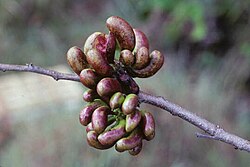Biology:Xylopia discreta
| Xylopia discreta | |
|---|---|

| |
| Fruit of Xylopia discreta[1] | |
| Scientific classification | |
| Kingdom: | Plantae |
| Clade: | Tracheophytes |
| Clade: | Angiosperms |
| Clade: | Magnoliids |
| Order: | Magnoliales |
| Family: | Annonaceae |
| Genus: | Xylopia |
| Species: | X. discreta
|
| Binomial name | |
| Xylopia discreta (L.f.) Sprague & Hutch.
| |
| Synonyms | |
|
Habzelia discreta (L.f.) A.DC. | |
Xylopia discreta is a species of plant in the Annonaceae family. It is native to Brazil , Colombia, French Guiana, Guyana, Suriname, and Venezuela.[3] Carl Linnaeus the Younger, the botanist who first formally described the species using the basionym Unona discreta, named it after its purple, aromatic fruit which set it apart (discretus in Latin) from other members of the family.[4][5][6]
Description
It is a tree reaching 22 meters in height. Its young branches are silky, narrow, and pliable. The lance-shaped, hairless, papery leaves are in two rows, alternate. Its petioles very short. The flower pedicels are clustered in umbels. The fruit are purple and aromatic.[5][7]
Reproductive biology
The pollen of Xylopia discreta is shed as permanent tetrads.[8]
Distribution and habitat
It has been observed growing in forests.[2]
Uses
Bioactive compounds extracted from its leaves and seeds have been reported to have antileishmanial activity in laboratory tests.[7]
References
- ↑ "Xylopia discreta (L. fil.) Sprague & Hutch.". Smithsonian Institution, NMNH, Botany. n.d.. https://eol.org/pages/1054224.
- ↑ 2.0 2.1 Botanic Gardens Conservation International (BGCI) & IUCN SSC Global Tree Specialist Group (2019). "Xylopia discreta". IUCN Red List of Threatened Species 2019: e.T143321886A143321888. doi:10.2305/IUCN.UK.2019-1.RLTS.T143321886A143321888.en. https://www.iucnredlist.org/species/143321886/143321888. Retrieved 19 June 2022.
- ↑ "Xylopia discreta (L.f.) Sprague & Hutch.". The Trustees of the Royal Botanic Gardens, Kew. n.d.. https://powo.science.kew.org/taxon/urn:lsid:ipni.org:names:76119-1.
- ↑ Stearn, William (2004). Botanical Latin. Portland, Ore. Newton Abbot: Timber Press David & Charles. ISBN 9780881926279.
- ↑ 5.0 5.1 Linné, Carolo (1782). Supplementum Plantarum. Brunswick: Orphanotropheum. p. 270. https://bibdigital.rjb.csic.es/viewer/11485/?offset=#page=286.
- ↑ Sprague, T.A.; Hutchinson, J. (1916). "XXVII. African Anonaceae". Bulletin of Miscellaneous Information 6: 145–161. https://www.biodiversitylibrary.org/page/11628192.
- ↑ 7.0 7.1 López, R.; Cuca, L.E.; Delgado, G. (2009). "Antileishmanial and Immunomodulatory Activity of Xylopia discreta". Parasite Immunology 31 (10): 623–630. doi:10.1111/j.1365-3024.2009.01134.x. PMID 19751474.
- ↑ Walker, J.W. (1976). "Evolutionary Significance of the Exine in the Pollen of Primitive Angiosperms". The Evolutionary Significance of the Exine. London: Academic Press. ISBN 978-0122536502.
Wikidata ☰ Q15366915 entry
 |


